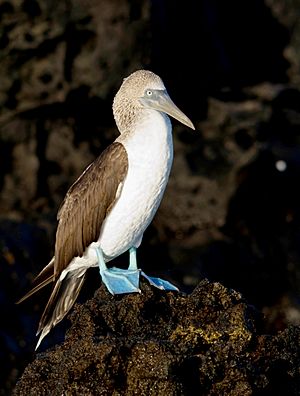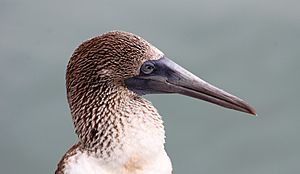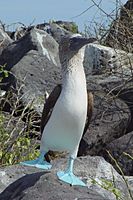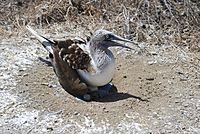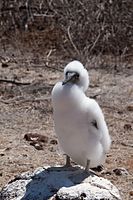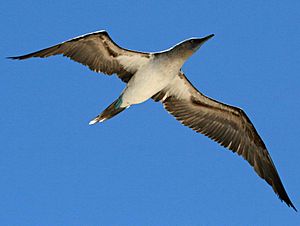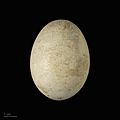Blue-footed booby facts for kids
Quick facts for kids Blue-footed boobyTemporal range: Holocene–recent
|
|
|---|---|
 |
|
| Conservation status | |
| Scientific classification | |
| Genus: |
Sula
|
| Species: |
nebouxii
|
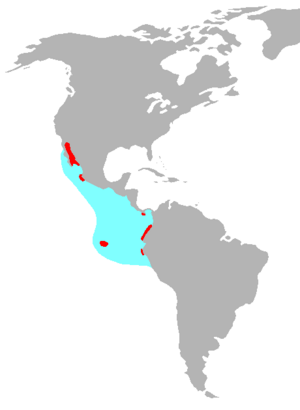 |
|
| Range shown by red area | |
The blue-footed booby (Sula nebouxii) is a cool marine bird that lives in the warm parts of the eastern Pacific Ocean. It's one of six types of birds called boobies. You can easily spot it because of its bright blue feet! These feet get their color from the fish the booby eats.
Male blue-footed boobies show off their blue feet in a special dance to attract females. They lift their feet up and down while strutting around. Female boobies are a bit bigger than males. They can grow up to 90 cm (35 in) long, and their wings can spread up to 1.5 m (5 ft).
Blue-footed boobies usually nest on tropical islands in the Pacific Ocean. You can find them from the Gulf of California all the way down to Peru. About half of all blue-footed booby pairs nest on the Galápagos Islands. They mostly eat fish, which they catch by diving into the water. Sometimes they hunt alone, but often they hunt in groups.
A female blue-footed booby usually lays one to three eggs. Unlike many other birds, they start warming the eggs as soon as the first one is laid. This means the chicks hatch at different times. The first chick to hatch is usually bigger than its younger siblings. If there isn't enough food, the older, stronger chick might harm its younger sibling. This makes the blue-footed booby interesting for scientists studying parent–offspring conflict and sibling rivalry.
Contents
What's in a Name?
The French scientist Alphonse Milne-Edwards first described the blue-footed booby in 1882. He gave it the scientific name Sula nebouxii. The second part of the name, nebouxii, honors a surgeon and explorer named Adolphe-Simon Neboux.
There are two types, or subspecies, of blue-footed boobies:
- S. n. nebouxii: Found along the Pacific coast of South and Central America.
- S. n. excisa: Found on the Galápagos Islands.
The blue-footed booby's closest relative is the Peruvian booby. They are very similar.
The name "booby" comes from the Spanish word bobo. This word means "stupid" or "foolish." People called them this because boobies can seem clumsy on land. They also don't seem to be afraid of humans.
Blue-Footed Booby Appearance
Blue-footed boobies are about 81 cm (32 in) long and weigh about 1.5 kg (3+1⁄4 lb). Females are a little bigger than males. Their wings are long, pointed, and brown. Their neck and head are light brown with white streaks. Their belly and underside are pure white.
Their eyes are on the sides of their beak but face forward. This gives them great binocular vision (seeing with both eyes). Their eyes are a bright yellow. Males usually have more yellow in their eyes than females. Baby boobies have black beaks and feet, and they are covered in soft white fluff. The boobies on the Galápagos Islands are larger and have lighter feathers around their neck and head.
The Peruvian booby looks similar, but it has gray feet. It also has a whiter head and neck, and white spots on its wings.
Blue-footed boobies dive headfirst into the water to catch fish. Because of this, their nostrils are always closed. They breathe through the corners of their mouth. Their most famous feature is their blue feet! The color can be light turquoise to deep aquamarine. Males and younger birds have lighter blue feet than females. These blue feet are very important for their courtship dances.
Where Blue-Footed Boobies Live
The blue-footed booby lives along the coasts of the eastern Pacific Ocean. You can find them from California down to the Galápagos Islands and into Peru. They are truly ocean birds. They only come to land to lay eggs and raise their young. They do this along the rocky coasts.
A booby pair might use a few nesting spots on bare black lava. These spots are small dips in the ground. They choose one favorite spot a few weeks before laying eggs. Many boobies nest together in large groups called colonies. When nesting, the female turns to face the sun all day long.
Starting a Family
Female boobies start breeding when they are 1 to 6 years old. Males start when they are 2 to 6 years old. Young boobies usually don't move far from where they were born to build their own nests. This is why you see hundreds of boobies nesting close together. Staying near their parents' successful nesting sites helps them find a good place. A good nest site protects them from predators and helps them take off and land easily. Sometimes, two females and one male might even share a single nest!
Why Their Feet Are Blue
The blue color of the blue-footed booby's webbed feet comes from special structures in their skin. These structures are made of proteins called collagens. The color also comes from pigments called carotenoids, which they get from eating fresh fish. Carotenoids are also good for the booby's immune system. This means bright blue feet can show how healthy a booby is.
If boobies don't eat for a couple of days, their feet become less bright. This is because they have less fat and other substances needed to carry the carotenoids. So, their feet quickly show how well-fed they are. Since bright blue feet show good health, females often choose males with brighter feet.
How Females Choose Mates
A male booby's feet get less bright as he gets older. Females tend to choose younger males with brighter feet. These males are often more fertile and better at taking care of chicks. In one study, chicks raised by foster fathers with brighter feet grew faster.
Females also keep an eye on their partner's foot color. If a male's feet were made duller with makeup after the first egg was laid, the female laid a smaller second egg. This suggests that if a male seems less healthy, the female might put less effort into the next egg. This is a smart way for females to decide how much to invest in their offspring.
How Males Choose Mates
Males also check out their female partners. Females who lay larger, brighter eggs are usually healthier. So, males tend to take better care of larger eggs. These eggs come from females who seem to be of good genetic quality. Smaller, duller eggs get less care from the male.
One study found that if a female had bright blue feet, males would care for both large and small eggs. But if the female had dull feet, males only cared for the larger eggs. This shows that both males and females use foot color to decide how much effort to put into raising their young.
Blue-Footed Booby Behavior
Hunting and Eating
Blue-footed boobies are expert fish eaters. They love small schooling fish like sardines, anchovies, mackerel, and flying fish. They also eat squid. They hunt by diving headfirst into the ocean, sometimes from very high up. They can also swim underwater to chase their prey.
They can hunt alone, in pairs, or in large groups. Boobies often travel in groups of about 12 birds to find big schools of fish. When the first bird spots fish, it signals to the others. Then, they all dive together, pointing their bodies down like arrows.
They can dive from heights of 10–30.5 m (33–100 ft), and even up to 100 m (330 ft)! These birds hit the water at about 97 km/h (27 m/s). They can go as deep as 25 m (80 ft) underwater. Their skulls have special air sacs that protect their brains from the huge pressure. They usually eat their prey while still underwater.
Males and females fish differently. Males are smaller and have bigger tails, which helps them fish in both shallow and deep waters. Females are larger and can carry more food. Both parents feed their chicks by bringing up (regurgitating) fish for them. If there isn't enough food for all the chicks, the parents will only feed the biggest one. This helps make sure at least one chick survives.
Reproduction and Life Cycle
Blue-footed boobies usually have one partner, but sometimes a male might have two female partners. They can breed every 8 to 9 months.
The male's courtship dance is very important. He shows off his blue feet and dances to impress the female. He starts by strutting and lifting his feet. Then, he might offer nest materials. The dance ends with a final display of his feet. He also does a "sky-pointing" move. This is when he points his head and beak to the sky, with his wings and tail raised.
Raising Young Boobies
The blue-footed booby is one of only two booby species that can raise more than one chick at a time.
The female lays two or three eggs, usually four to five days apart. Both parents take turns sitting on the eggs to keep them warm. Since boobies don't have a special bare patch of skin for warming eggs, they use their feet! The eggs hatch after 41–45 days. Usually, one or two chicks survive from the eggs laid.
Both parents share the job of raising the chicks. The male often brings food early on because he's good at diving. The female takes over when the chicks need more food. Chicks eat the fish that the adults bring up from their stomachs.
Female blue-footed boobies sometimes favor smaller chicks if food is scarce. Female chicks grow faster than males, so they need more food. Studies show that mothers might adjust how much they feed their chicks to help them survive.
Sibling Rivalry
Blue-footed boobies lay eggs a few days apart. The first egg hatches first, giving that chick a head start in growth. This difference in hatching times helps space out the hard work of feeding tiny chicks. It also reduces the chance that all chicks will be lost to predators.
This "asynchronous" hatching also creates a clear pecking order among the chicks. The older, stronger chick is called the A-chick. The younger one is the B-chick. If there isn't enough food, the A-chick might be aggressive towards the B-chick. It might peck it or even push it out of the nest. This is called facultative siblicide. It means they might kill a sibling depending on how much food there is.
The A-chick always gets food before the B-chick. Even if the younger chick begs for food, the older, bigger chick usually gets the parents' attention first. However, sometimes the older chick might share a little food during short food shortages. But if food is scarce for a long time, the older chick usually becomes aggressive.
Parents and Siblicide
Blue-footed booby parents usually don't stop their chicks from fighting. They even seem to help the older chick by feeding it more often. This might seem harsh, but it could be a way for parents to make sure at least one strong chick survives when food is limited. The second egg might be like "insurance" in case the first egg doesn't hatch or if there's more food than expected.
However, parents might not be as uncaring as they seem. Blue-footed boobies build nests with steep sides. This makes it harder for the older chick to push the younger one out. When scientists flattened these nests, the parents rebuilt them to be steep again. This shows that parents do try to protect their younger chicks. Parents also seem to feed chicks that are in poorer condition more often when food is scarce.
How Boobies Talk
Blue-footed boobies make loud grunts, shouts, and thin whistling sounds. Males are known to throw their heads back and whistle at females flying by. These special dances and sounds are how they communicate.
Mates can recognize each other just by their calls. Both males and females can tell their partner's call from other boobies.
Why Booby Numbers Are Falling
Scientists are worried about a drop in the blue-footed booby population on the Galápagos Islands. A study in 2014 confirmed that their numbers are indeed going down. It seems the boobies are having trouble breeding.
The main reason for this decline might be a lack of food, especially sardines. Sardines are a very important part of the boobies' diet. Since 1997, sardines have been largely missing from the Española Island area. This means the boobies don't have enough of their favorite food, which makes it harder for them to breed. Scientists haven't found other reasons for the decline, like human impact, new predators, or diseases.
Images for kids
See also
 In Spanish: Pájaro bobo de patas azules para niños
In Spanish: Pájaro bobo de patas azules para niños




